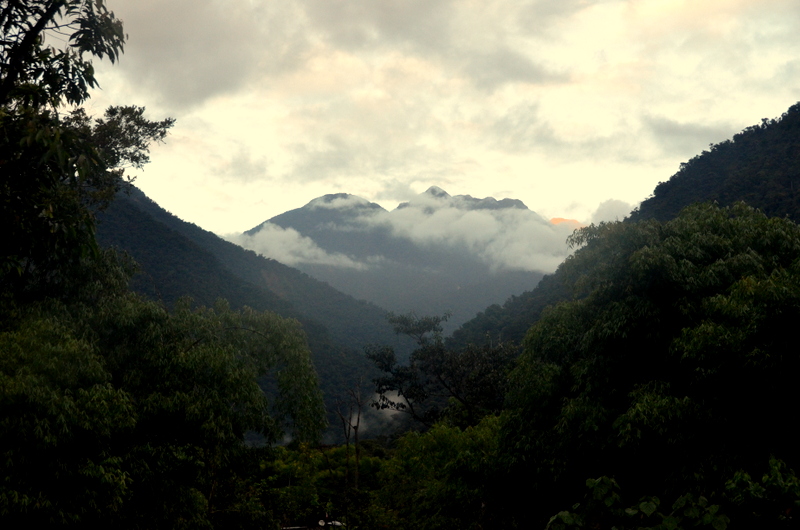I never would have noticed it as I hiked down through a dense Andean cloud forest. The stubby tree with broad, thick leaves stood out no more to me than the endless jungle depths of ferns, schefflera and tree-clinging epiphytes. But to tropical biologist Ken Feeley, it stood out clearly – especially at a chilly elevation of 8,000 feet.
"See that?" Feeley said to me, pointing off the trail about 50 yards away. "There we have something in the rubiaceae, or coffee, family. It might just be an anecdote, or it might just be the first observation of that species upslope."
I snapped a photo. Feeley continued his explanation: "There are known accounts that coffee as an agricultural product is moving up the slope with farmers planting it higher and higher. The cultivated coffee-growing areas in the lowlands are seeing decreased yields."
This made me wonder: is it good to see a coffee plant at this elevation?
To the relief and potential horror of caffeine addicts everywhere, Feeley said, "To see species move upslope, that means they are responding to climate change. So that's a good thing. Because if they don't respond, they are almost certainly doomed to extinction."
So, could coffee become an imperiled species, threatened by the steady march of climate change? It's too soon to tell, but in remembering that jungle conversation I had in southern Peru last summer, I found some clues in Justin Gillis' page-one story in The New York Times on Nov. 2 under the headline: "Climate Change Seen Posing Risk To Food Supplies."
Gillis had been leaked a draft report by the UN's Intergovernmental Panel on Climate Change. The panel's conclusions, to be released next March, are dire. They also reflect what I witnessed in the Amazon basin last summer and heard from the biologists whom I interviewed in the field.
In quoting from the leaked UN document, Gillis wrote that the agricultural risks of climate change "are greatest for tropical countries, given projected impacts that exceed adaptive capacity and higher poverty rates compared with temperate regions."
As I learned in my reporting last summer, in temperate or cold climates, trees and plants are adapted to wide temperature ranges and can migrate to latitudes for many miles north to stay in their ecological comfort zones. In the tropics, where most of the world's biodiversity exists, trees and plants live in extremely narrow temperature ranges. To survive, they will need to reproduce in higher altitudes where space is far more limited and upslope soils might not be accommodating – hence the possible threat to coffee growing in the future.
"As human, we sometimes think we are completely disconnected from the natural world, that agriculture is a completely manmade phenomenon," said Feeley, who is on the faculty at Florida International University. "But agriculture relies very much on the natural world. So disruption in the natural world is going to have an impact on crops and it's going to affect us."
Through his research, Feeley predicts significant species population reductions and extinctions in the next 50 to 75 years due to climate change. His tree-migration findings in both Peru and Costa Rica argue that temperatures are rising faster than a lot of plant species have time to adapt.
Climate-change skeptics are quick to rationalize the benefits of more CO2 in the air. They say more CO2 enhances some plant life, which is marginally true. And they say that global warming has the potential to add farmland in northern latitudes currently too cold to farm, which has a surface appeal, too.
I put that those scenarios to Miles Silman, a tropical biologist at Wake Forest University with whom I was also hiking through the Amazon basin last summer.
"You can move crops northward," Silman told me. "Canada can become more productive, assuming the soils can handle it. So maybe (crop) productivity increases in the high latitudes. But it's going to decrease in the southern ones."
Silman wondered about the fairness of such a scenario.
"If you look at places where crop yields are expected to decline, it's in some of the poorest and most populated places in the world, like all of central Africa," Silman said. "Then look at India. Crop yields there are predicted to do down a lot. There're a billion people there now."
Feeley added, "Most of the crop yields needed to feed an extra 2 billion people who are going to be on the planet by 2050 are in the tropics. If you can't increase yields in those areas, then you're in trouble."
Expect the UN Intergovernmental Panel on Climate Change, which was awarded a Nobel Peace Prize in 2007, to conclude precisely that when its official findings are released next March.







